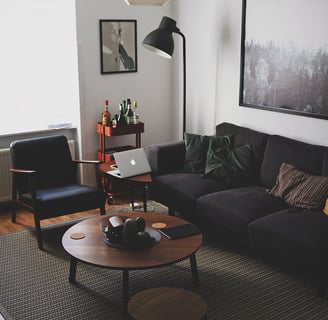Size Guide
This guide will help you determine your measurements for the perfect fit every time, labels be damned.
12/8/20234 min read


You may have noticed that Piecey does not include traditional size filters. This is in large part due to the considerable variation between vintage and modern sizing — there is nothing quite like buying a final sale garment labeled size 12 only to find it has been listed incorrectly and really should have been sold as a modern size 4. (I'm looking at you, Poshmark.)
None of our pieces will be advertised with scalar sizing for that exact reason. Instead, each piece includes detailed measurements that you can check to ensure proper fit. Knowing your measurements is not only helpful for navigating our shop but is also a necessary facet of tailoring clothes to fit the way you want.
If you are already familiar with your own measurements, we encourage you to check out the shop. Remember, a garment's measurements represent a maximum, so think of those numbers as "up to ____ ": we are all human and our shape changes throughout the day, so use your knowledge of your body to get clothes that will feel good for you.
If you are not familiar with your own measurements, keep reading! Whether or not you buy something from Piecey, we hope you take away new knowledge that you can use and share. We advise taking these measurements with a friend after a good meal to make the process fun and simple: one person stands while the other measures, then switch - win, win!
The most important baseline measurements you should have are: bust and front length for all tops; shoulder length for coats; and waist, hips, and inseam for all bottoms. Dresses will combine your top and bottom measurements, with an optional waist-to-hem length if you are searching for floor-length attire. The best tool to use for these measurements is a tailor's tape; however, it is not necessary. Just find yourself a flexible, non-stretch strip like a string or ribbon (which we will call this "tape" in the directions) and a ruler or tape measure (like from a toolbox). We will call this the "intro method." If using a tailor's tape, be sure to check the reliability of your tape against a ruler before you begin. (Older tapes can stretch over time and lose their accuracy, while newer tapes may be inaccurate due to manufacturing errors.)
Let's begin!
Bust size: Alternatively described as "full bust," this will be the circumference around the largest part of your chest. Make sure to take this measurement with the undergarments you typically wear (padded bra, no bra, binding, et cetera). Wrap the tape around your back and have the end meet the rest of the tape in front of you. Using a mirror or a friend's help, make sure that the tape is following an even, horizontal path all the way around, checking that the tape is level under each arm. If you are using the intro method, place a marker at the continuous edge of the tape where it meets the end of the tape. Your marker could simply be your thumbnail or you can try putting a safety pin through your string or ribbon so that your place marker does not shift. Next, use your ruler to measure the length of the tape to where you have marked and record the measurement.
Tip: Once you have the tape in the correct position, gently breathe to relax; the measurement should be close to your body but should not be squeezing or constricting, which can happen — fittings can sometimes cause anxiety as we connect more with our bodies. Remember, you do not need to change to fit clothing; clothing should change to help you feel comfortable and confident.
Front length: While this sometimes refers to the length from your neck to your waist, we will be measuring this as your full upper body length — when wearing a shirt, how long do you want it to be? Isolating this length will make sure you are not trying to stuff excess fabric into your bottom layer or struggling with unintentional flashing when you lift your arms. (We love an intentional midriff peek.) Take your tape and place the end at the apex of your non-dominant shoulder, holding that in place with the non-dominant hand. Using your dominant hand, place the tape down your front following a flat path, stopping wherever you prefer your shirts to sit. Do you want them to graze your waistline? Extend to your hips for easy tucking? Whatever way you wear your tops, mark the length, measure, and record.
Shoulder length: I do not typically see this in listings for vintage clothing and some would not consider this a baseline measurement. However, I would argue that it is critical for outerwear in particular, and appropriate outerwear is a human right.
Waist: This is the smallest part of your torso, generally where your rib cage ends. An easy way to confirm that you're in the correct place for your body is to lean to one side and, on the side that you are leaning towards, place your thumb in the spot where you are bending; it will be closest to your center point. Repeat on the other side. This is your waist! Similar to the bust measurement, wrap your tape around your back, making sure that the tape is level all the way around. Breathe in gently to keep , mark, measure, and record.
Hips: Alternatively described as "low hip," this is the fullest part of your lower body. I have thick outer thighs, so my hip measurement is lower than shown in typical measurement guides. It can be uncomfortable, but it is important acknowledge so you never have to struggle into clothes or feel that clothes are straining inappropriately. (We love ruching for a purposeful look that won't stress out you or the clothing.) Again, wrap the tape around your backside, making sure that the tape is level all the way around. Make sure the tape is gently resting close to your body and is not squeezing. Mark, measure, and record.
Inseam: This is the length from your crotch to your ankle and will determine whether pants will be the correct length for your legs. Make sure you are wearing form fitting bottoms as you begin to get an accurate measurement. If you are doing this with a friend and want to keep some distance from each other's crotches (totally fair), place the end of the tape on the front of the thigh, level with the crotch point. Measure down the front of the leg to your preferred stopping point. I prefer my pants to cover my ankle, so I stop just after my ankle; you may wish to stop at your ankle or just above. If you are measuring on your own, begin by placing the end of the tape at the interior of your thigh where it meets your crotch. Then let the tape extend to the ground and hold the tape taut with your heel. Now bend down, keeping tension in the end of the tape with your hand. Mark in your preferred spot, measure, and record.


